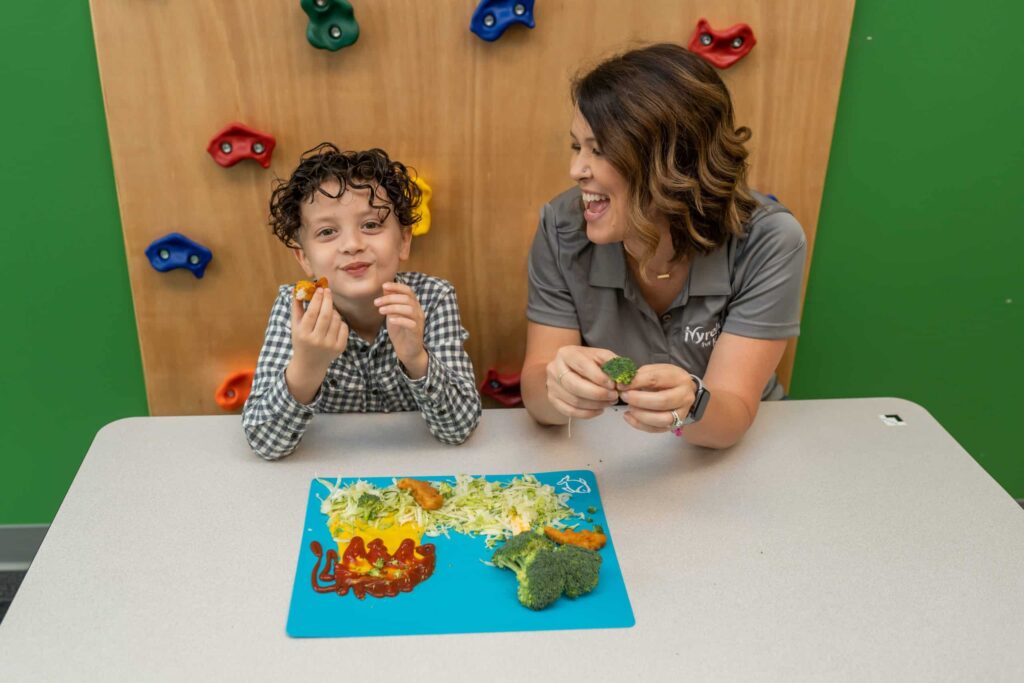Food is one of the basic human needs that we need to survive. We all have our favorites in each of the five food groups – fruits, vegetables, grains, proteins, and dairy – but it is important to eat food from each group for proper nutrition. However, picky eaters may not be getting the proper variety of foods in their diets and are unwilling to try new foods, which can lead to challenging mealtimes and poor nutritional intake. Understanding these habits and what causes them can help determine how to manage or .
What causes a child to be a picky eater?
While the or habit may be common for children, it’s important to know what can cause a to be a . The actual task of eating is the most complex thing our body does. This is because all our organ systems are working together, and our sensory systems are working together. Therefore, there may not be one distinct reason your child is a picky eater.
Picky eating factors can include:
- Physical limitations such as swallowing difficulties or pain when eating
- A history of a traumatic event, including choking or an allergic reaction to food
- Prematurity and/or having a history of a feeding tube
- Parental feeding habits
- Timing of introduction of solids and vegetables
- The presence of sensory processing disorders
For example, if a child has increased sensitivity to food textures and does not engage in messy play, or does not like to be dirty, texture and food sensitivities may be present. This child may be labeled a “picky eater” and limit the variety of foods in their diet based on texture. Or, if a child has a history of choking, they may start to refuse challenging solid foods and prefer only pureed food or food that is easy to chew, such as bread and other starchy foods.
Should you force your child to eat food they don’t like?
No! It is not a good idea to force your child to eat something they don’t like. It is also not good to bribe your child to eat something, for example, saying, “if you try this, you get to buy a new toy!” Bribing has not been shown to lead to lasting changes in a child’s eating habits.
In most cultures, eating is a positive social experience, so forcing the child to eat something they do not like can create a negative association with that food. Furthermore, it can promote continued refusal of that food because it is now associated with an upsetting or stressful situation.
Managing and encouraging picky eating
Instead, take a step back and encourage picky eaters to:
- Play with their food – make eating fun and be silly with it; make food into faces, paint with purees, or build towers to knock over with solid foods.
- Just smell the food – this gives additional sensory input and is closely linked to taste. Some foods have stronger smells than others and can deter sensory-sensitive children.
- Touch the food – using their hands, lips, or tongue to touch the food before eating will allow them to explore the texture and get comfortable with it. If they are sensitive to messy play, encourage messy play with non-food items at other times throughout the day.
- Allow it to sit on their plate – do not pressure them into trying it. When it sits on their plate it gives them some control over if, when, and how they want to try it.
Repeated exposure at this level will help children become more comfortable with non-preferred foods, eventually working up to eating.
Additionally, children learn from observation and structure. Some of the best ways to increase a child’s willingness to try new foods are to:
- Plan mealtimes together or have them involved in grocery shopping
- Encourage them to help pack their own lunch
- Model positive interactions with any and all foods
- Talk about their properties, for example, is food hard or soft, wet or dry
- Stay away from labeling food as “good” and “bad” to help maintain positive relationships with food in general
- Teach them how to eat the food so they are more confident in managing it in their mouth
Additionally, instead of forcing your child to eat, continue the repeated presentation of non-preferred food, and positive reinforcement such as verbal praise for any interaction with that food. This can lead to increased willingness and comfort with trying new foods. It’s important to build by either introducing the creatively or with positive reinforcement to manage .
Is being a picky eater a disorder?
It is important to remember the difference between “picky eating” and “problem eating.”
One of the most significant differences is the number of foods in their diet. A “picky eater” has about 30 or more foods in their diet and at least one from each food group. A child identified as a “picky eater” can more easily work through the steps to eating and expanding their diet to .
A “problem eater” has about 20 foods or less and eliminates an entire food group. They often take more time to work through those steps and may refuse to interact with non-preferred food.
In either situation, if it impacts participation in everyday life, it should be addressed in therapy. If the problem persists and a child shows symptoms such as weight loss, nutritional deficiencies, and fatigue or weakness, you should consult with your pediatrician. After a complete exam, a medical doctor may diagnose them with conditions such as failure to thrive or ARFID (avoidant/restrictive food intake disorder).
Can picky eaters change?
Absolutely! Occupational therapy can help with that. Through therapy, a child can learn to expand their diet and accept more foods. The amount of time this takes will look different for each child and family and could be a slow process. In fact, there are 32 steps to eating. The 6 broad categories are as follows, with baby steps in each:
- Tolerates
- Interacting with
- Smells
- Touch
- Taste
- Eating
The most progress is seen when the family works closely with the therapist and implements strategies at home on a daily basis. For example, starting with giving small amounts not to overwhelm the child and allowing them to just accept it on their plate with no expectation to eat. Also, always encourage play with food to build up tolerance and acceptance.
Adults and caregivers must be able to read the child’s cues and meet them at their level in a playful way during all mealtimes. It is important to remember that although a child may not eat every new food offered, any interaction with the food in a positive manner is progress! Was the child able to look at the food, smell the food, touch the food, lick the food- that is all progress made and will eventually lead to the child eating more food! And as previously mentioned, providing positive reinforcement, typically natural verbal praise, for those interactions can support long-term change in a child’s eating habits. Just like adults have food likes and dislikes, a child does too!
How Feeding Therapy Can Help
Feeding therapy can help your child and family learn creative ways to expand your child’s diet. First, a skilled occupational therapist will complete an evaluation assessing all factors that could impact participation in mealtime. Then, they will collaborate with the family and create goals and a plan of care to support your child.
Recognizing dysregulation in your child is also a crucial step since this can cause children not to feel the sensation of hunger, which leads to decreased interest in wanting to eat.
Using a play-based approach, therapists can incorporate sensory regulation activities that prepare your child to be able to feel hungry and sit at the table to eat. Occupational therapists will work through the steps to eating and work with your child to explore new foods through positive discussion and interaction with the food’s texture, color, shape, and taste.
If your child shows signs of picky eating habits, such as aversive reactions to new foods presented, refusal to try new foods, and elimination of foods previously enjoyed, occupational therapy will be beneficial. It is also important to seek help from a professional sooner rather than later, as changing a child’s relationship and perspective on trying new foods at a younger age is easier. Find a clinic near you and get in touch with us today!
Article By: Courtney Besso, MS, OTR/L
Courtney began her occupational therapy career three and a half years ago. Courtney loves working with the pediatric population and believes in the importance of providing quality, family-centered care. She specializes in sensory regulation, feeding, and fine motor delays. Courtney enjoys working with children of all ages to reach their full potential. She treats patients at Ivy Rehab for Kids in North Wales, PA.







